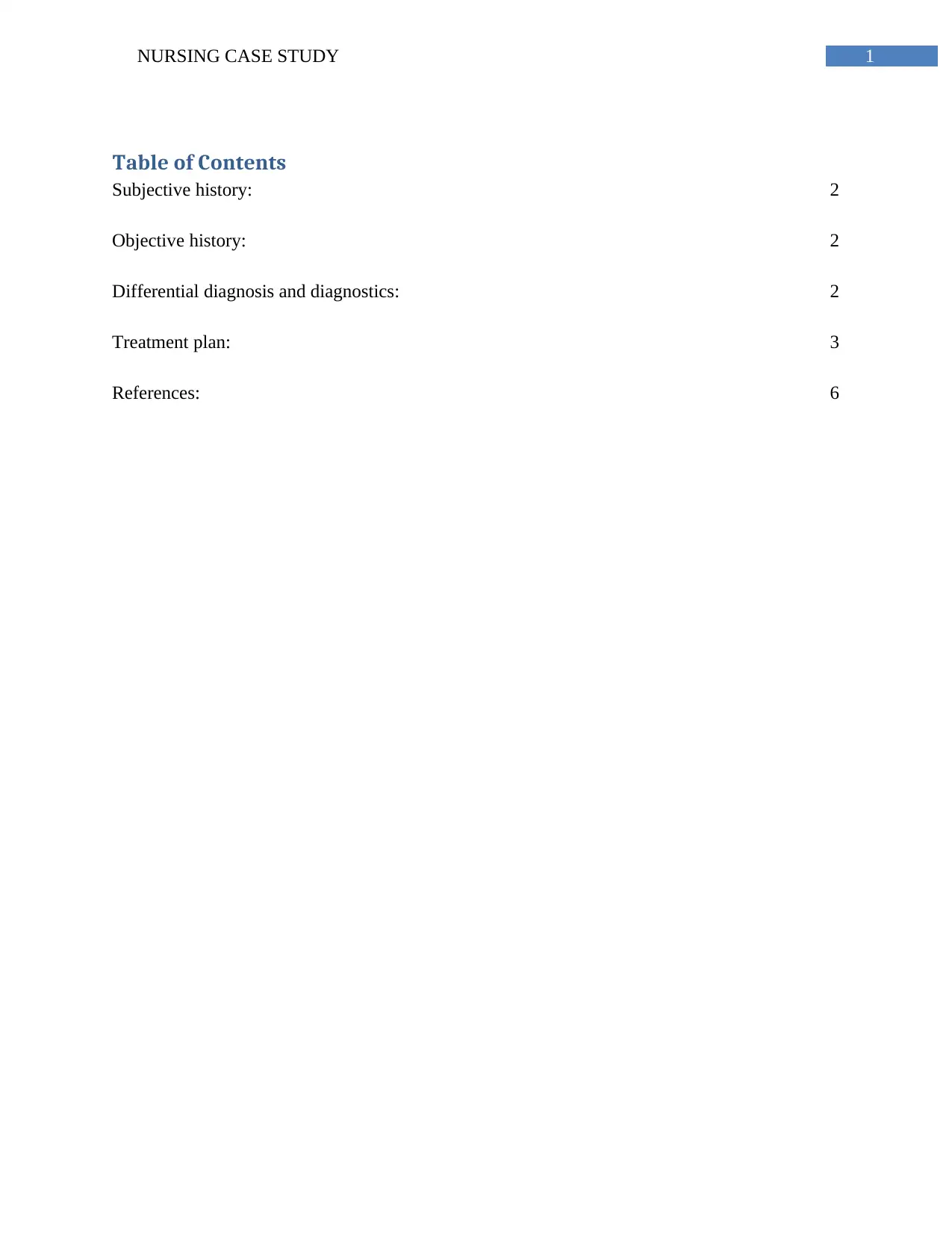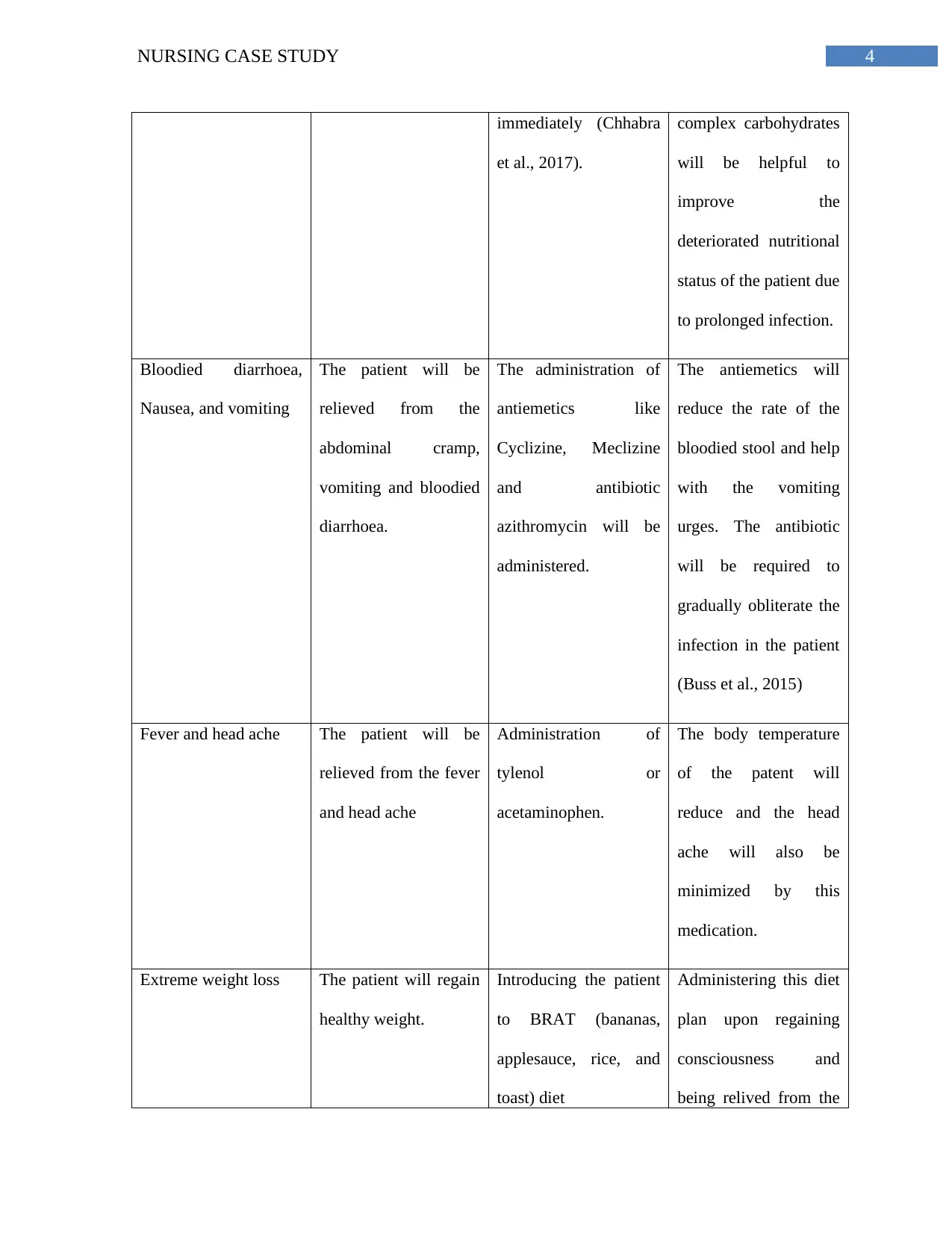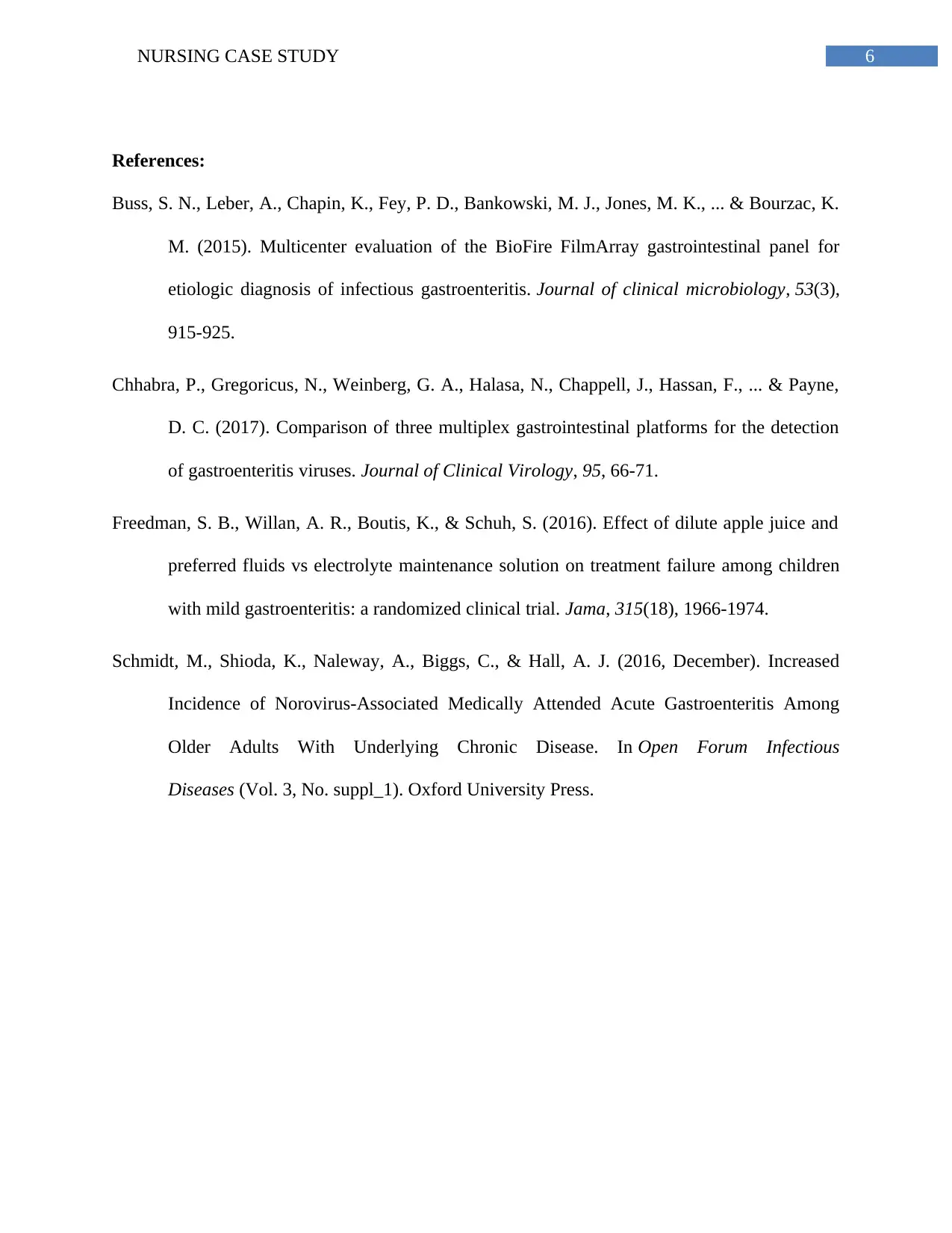Detailed Case Study: Diagnosis & Treatment Plan for Gastroenteritis
VerifiedAdded on 2023/06/15
|7
|1089
|432
Case Study
AI Summary
This nursing case study details the presentation, diagnosis, and treatment of a 75-year-old male patient with gastroenteritis. The patient presented with symptoms including unintentional weight loss, high fever, vomiting, abdominal pain, and bloody stools. Initial differential diagnoses considered bacterial gastroenteritis, helminthic infections, and Giardia infection. Diagnostic tests, including stool microscopy, stool antigen tests, and lactoferrin immunoassay, confirmed bacterial gastroenteritis caused by Yersinia enterocolitica. The treatment plan involved rehydration therapy, antiemetics, antibiotics, and acetaminophen for fever and headache. A BRAT diet was introduced to encourage healthy weight gain during recovery. The case study highlights the importance of accurate diagnosis and comprehensive nursing care in managing gastroenteritis in elderly patients.

Running head: NURSING CASE STUDY
Nursing case study
Name of the study:
Name of the university:
Author note:
Nursing case study
Name of the study:
Name of the university:
Author note:
Paraphrase This Document
Need a fresh take? Get an instant paraphrase of this document with our AI Paraphraser

1NURSING CASE STUDY
Table of Contents
Subjective history: 2
Objective history: 2
Differential diagnosis and diagnostics: 2
Treatment plan: 3
References: 6
Table of Contents
Subjective history: 2
Objective history: 2
Differential diagnosis and diagnostics: 2
Treatment plan: 3
References: 6

2NURSING CASE STUDY
Subjective history:
The patient in the case study had been a 75 year old male individual who had been presented
in the health care facility with unintentional weight loss of 15 pounds. The patient, when
questioned, revealed that he had also been suffering from high fever and along with that had
recently been experiencing vomiting and abdominal pain along with bloodied stool for the past
few days. On further inquiry, the patient revealed that he lives alone in his house with no one to
care for him, and had been experiencing the onset of the symptoms since the last couple of
months.
Objective history:
The objective history of the patient indicates at a low respiratory rate at 16 breaths per
minute. Along with that, the patient’s body temperature had also been considerably high at 102.
However, it has to be mentioned that the blood pressure of the patents was fairly normal at
120/90. The heart rate of the patient on the other hand had been slightly higher. It has to be
mentioned in this context as well that the patient in this case had also been suffering from
abdominal cramps and mild head ache as well.
Differential diagnosis and diagnostics:
It has to be mentioned in this context that the patient under consideration had been exhibiting
the key symptoms of any infectious disease manifestation in the gastro-intestinal tract. The major
signs had been the bloody stools accompanied by the acute and persistent abdominal pain and
cramps. Hence, the most plausible diagnosis for the patient can be stomach flu. Now it has to be
understood that the stomach flu is an umbrella term that takes into consideration a vast range of
Subjective history:
The patient in the case study had been a 75 year old male individual who had been presented
in the health care facility with unintentional weight loss of 15 pounds. The patient, when
questioned, revealed that he had also been suffering from high fever and along with that had
recently been experiencing vomiting and abdominal pain along with bloodied stool for the past
few days. On further inquiry, the patient revealed that he lives alone in his house with no one to
care for him, and had been experiencing the onset of the symptoms since the last couple of
months.
Objective history:
The objective history of the patient indicates at a low respiratory rate at 16 breaths per
minute. Along with that, the patient’s body temperature had also been considerably high at 102.
However, it has to be mentioned that the blood pressure of the patents was fairly normal at
120/90. The heart rate of the patient on the other hand had been slightly higher. It has to be
mentioned in this context as well that the patient in this case had also been suffering from
abdominal cramps and mild head ache as well.
Differential diagnosis and diagnostics:
It has to be mentioned in this context that the patient under consideration had been exhibiting
the key symptoms of any infectious disease manifestation in the gastro-intestinal tract. The major
signs had been the bloody stools accompanied by the acute and persistent abdominal pain and
cramps. Hence, the most plausible diagnosis for the patient can be stomach flu. Now it has to be
understood that the stomach flu is an umbrella term that takes into consideration a vast range of
⊘ This is a preview!⊘
Do you want full access?
Subscribe today to unlock all pages.

Trusted by 1+ million students worldwide

3NURSING CASE STUDY
different microbial infections (Buss et al., 2015). In this case the differential diagnosis for the
patient includes bacterial gastroenteritis, Helminthic infections and Giardia infection.
It has to be mentioned that in case of the all mentioned three health conditions are associated
with the basic symptoms that the patients had been exhibiting as well. However, for Helminthic
infections are only common for patients that are immuno-compromised which had not been the
case for Mr. Miller. Hence this diagnosis was ruled out for the patient in the case study; the
diagnostic test that has been carried out for the patient had been the stool microscopy test
(Schmidt et al., 2016). The results of the stool microscopy and culture indicated at the evidence
of inflammation and the culture of enteropathogenic bacteria. The results indicate at the bacterial
gastroenteritis, although the possibility of Giardia infection cannot be ruled out completely
either.
For further confirmation of the preliminary diagnosis, two more diagnostic tests were
performed; the first had been the stool antigen test; which was negative for Giardia infection.
The final test had been lactoferrin immunoassay. This test was positive confirming the bacterial
gastroenteritis as the final diagnosis, Yersinia enterocolitica was discovered to be the causal
pathogenic organism (Freedman et al., 2016).
Treatment plan:
Nursing diagnosis Nursing objective Strategic intervention Rationale
Severe prolonged
gastroenteritis with
extreme dehydration
The patient will be
rehydrated.
Oral and intravenous
rehydration therapy
will need to be
administered
The intravenous
rehydration with
drinking replacement
products based on
different microbial infections (Buss et al., 2015). In this case the differential diagnosis for the
patient includes bacterial gastroenteritis, Helminthic infections and Giardia infection.
It has to be mentioned that in case of the all mentioned three health conditions are associated
with the basic symptoms that the patients had been exhibiting as well. However, for Helminthic
infections are only common for patients that are immuno-compromised which had not been the
case for Mr. Miller. Hence this diagnosis was ruled out for the patient in the case study; the
diagnostic test that has been carried out for the patient had been the stool microscopy test
(Schmidt et al., 2016). The results of the stool microscopy and culture indicated at the evidence
of inflammation and the culture of enteropathogenic bacteria. The results indicate at the bacterial
gastroenteritis, although the possibility of Giardia infection cannot be ruled out completely
either.
For further confirmation of the preliminary diagnosis, two more diagnostic tests were
performed; the first had been the stool antigen test; which was negative for Giardia infection.
The final test had been lactoferrin immunoassay. This test was positive confirming the bacterial
gastroenteritis as the final diagnosis, Yersinia enterocolitica was discovered to be the causal
pathogenic organism (Freedman et al., 2016).
Treatment plan:
Nursing diagnosis Nursing objective Strategic intervention Rationale
Severe prolonged
gastroenteritis with
extreme dehydration
The patient will be
rehydrated.
Oral and intravenous
rehydration therapy
will need to be
administered
The intravenous
rehydration with
drinking replacement
products based on
Paraphrase This Document
Need a fresh take? Get an instant paraphrase of this document with our AI Paraphraser

4NURSING CASE STUDY
immediately (Chhabra
et al., 2017).
complex carbohydrates
will be helpful to
improve the
deteriorated nutritional
status of the patient due
to prolonged infection.
Bloodied diarrhoea,
Nausea, and vomiting
The patient will be
relieved from the
abdominal cramp,
vomiting and bloodied
diarrhoea.
The administration of
antiemetics like
Cyclizine, Meclizine
and antibiotic
azithromycin will be
administered.
The antiemetics will
reduce the rate of the
bloodied stool and help
with the vomiting
urges. The antibiotic
will be required to
gradually obliterate the
infection in the patient
(Buss et al., 2015)
Fever and head ache The patient will be
relieved from the fever
and head ache
Administration of
tylenol or
acetaminophen.
The body temperature
of the patent will
reduce and the head
ache will also be
minimized by this
medication.
Extreme weight loss The patient will regain
healthy weight.
Introducing the patient
to BRAT (bananas,
applesauce, rice, and
toast) diet
Administering this diet
plan upon regaining
consciousness and
being relived from the
immediately (Chhabra
et al., 2017).
complex carbohydrates
will be helpful to
improve the
deteriorated nutritional
status of the patient due
to prolonged infection.
Bloodied diarrhoea,
Nausea, and vomiting
The patient will be
relieved from the
abdominal cramp,
vomiting and bloodied
diarrhoea.
The administration of
antiemetics like
Cyclizine, Meclizine
and antibiotic
azithromycin will be
administered.
The antiemetics will
reduce the rate of the
bloodied stool and help
with the vomiting
urges. The antibiotic
will be required to
gradually obliterate the
infection in the patient
(Buss et al., 2015)
Fever and head ache The patient will be
relieved from the fever
and head ache
Administration of
tylenol or
acetaminophen.
The body temperature
of the patent will
reduce and the head
ache will also be
minimized by this
medication.
Extreme weight loss The patient will regain
healthy weight.
Introducing the patient
to BRAT (bananas,
applesauce, rice, and
toast) diet
Administering this diet
plan upon regaining
consciousness and
being relived from the

5NURSING CASE STUDY
severe dehydration to
encourage healthy
weight gain (Schmidt
et al., 2016).
severe dehydration to
encourage healthy
weight gain (Schmidt
et al., 2016).
⊘ This is a preview!⊘
Do you want full access?
Subscribe today to unlock all pages.

Trusted by 1+ million students worldwide

6NURSING CASE STUDY
References:
Buss, S. N., Leber, A., Chapin, K., Fey, P. D., Bankowski, M. J., Jones, M. K., ... & Bourzac, K.
M. (2015). Multicenter evaluation of the BioFire FilmArray gastrointestinal panel for
etiologic diagnosis of infectious gastroenteritis. Journal of clinical microbiology, 53(3),
915-925.
Chhabra, P., Gregoricus, N., Weinberg, G. A., Halasa, N., Chappell, J., Hassan, F., ... & Payne,
D. C. (2017). Comparison of three multiplex gastrointestinal platforms for the detection
of gastroenteritis viruses. Journal of Clinical Virology, 95, 66-71.
Freedman, S. B., Willan, A. R., Boutis, K., & Schuh, S. (2016). Effect of dilute apple juice and
preferred fluids vs electrolyte maintenance solution on treatment failure among children
with mild gastroenteritis: a randomized clinical trial. Jama, 315(18), 1966-1974.
Schmidt, M., Shioda, K., Naleway, A., Biggs, C., & Hall, A. J. (2016, December). Increased
Incidence of Norovirus-Associated Medically Attended Acute Gastroenteritis Among
Older Adults With Underlying Chronic Disease. In Open Forum Infectious
Diseases (Vol. 3, No. suppl_1). Oxford University Press.
References:
Buss, S. N., Leber, A., Chapin, K., Fey, P. D., Bankowski, M. J., Jones, M. K., ... & Bourzac, K.
M. (2015). Multicenter evaluation of the BioFire FilmArray gastrointestinal panel for
etiologic diagnosis of infectious gastroenteritis. Journal of clinical microbiology, 53(3),
915-925.
Chhabra, P., Gregoricus, N., Weinberg, G. A., Halasa, N., Chappell, J., Hassan, F., ... & Payne,
D. C. (2017). Comparison of three multiplex gastrointestinal platforms for the detection
of gastroenteritis viruses. Journal of Clinical Virology, 95, 66-71.
Freedman, S. B., Willan, A. R., Boutis, K., & Schuh, S. (2016). Effect of dilute apple juice and
preferred fluids vs electrolyte maintenance solution on treatment failure among children
with mild gastroenteritis: a randomized clinical trial. Jama, 315(18), 1966-1974.
Schmidt, M., Shioda, K., Naleway, A., Biggs, C., & Hall, A. J. (2016, December). Increased
Incidence of Norovirus-Associated Medically Attended Acute Gastroenteritis Among
Older Adults With Underlying Chronic Disease. In Open Forum Infectious
Diseases (Vol. 3, No. suppl_1). Oxford University Press.
1 out of 7
Related Documents
Your All-in-One AI-Powered Toolkit for Academic Success.
+13062052269
info@desklib.com
Available 24*7 on WhatsApp / Email
![[object Object]](/_next/static/media/star-bottom.7253800d.svg)
Unlock your academic potential
Copyright © 2020–2025 A2Z Services. All Rights Reserved. Developed and managed by ZUCOL.





